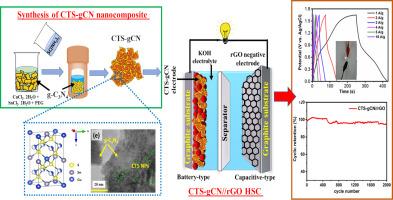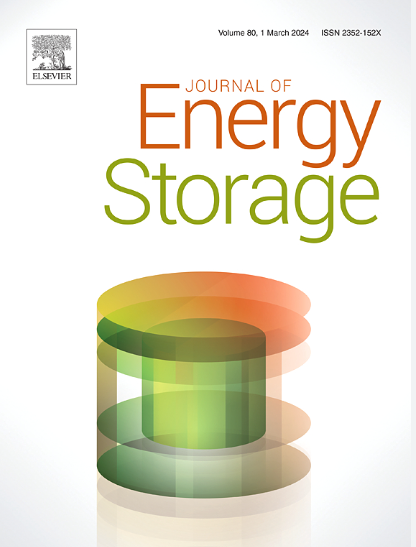Investigation of Cu2SnS3 nanoparticles decorated g-C3N4 nanocomposites for high performance battery-type hybrid supercapacitors
IF 8.9
2区 工程技术
Q1 ENERGY & FUELS
引用次数: 0
Abstract
The hybrid-type of supercapacitors based on transition metal sulfides-carbon composite electrodes are found to be a prominent and emerging technological advancement with beneficial characteristics such as a larger surface area, high durability, and a unique charge storage mechanism. In this work, phase pure copper tin sulfide (Cu2SnS3/CTS) nanoparticles (NPs) and the nanocomposite of CTS NPs decorated graphitic carbon nitride (g-C3N4) CTS-gCN were prepared by an inexpensive solvothermal approach. The CTS-gCN nanocomposite-based supercapacitors show a high specific capacitance of 477 F/g at 1 A g−1 current density, which is much higher than the pristine CTS NPs based supercapacitors (362 F/g) in three electrode configurations. The asymmetric hybrid supercapacitors were prepared with CTS-gCN electrodes and reduced graphene oxide (rGO) as a negative electrode with potassium hydroxide (KOH) as an electrolyte. The electrochemical characteristics of asymmetric CTS-gCN//rGO supercapacitors exhibit battery-like behavior with a specific capacitance of 108 F/g at the scan rate of 1 A g−1 with a high energy density of 42 W h kg−1 and a power density of 835.4 W kg−1. The CTS-gCN//rGO supercapacitors show excellent capacitance retention over 94 % even after 2000 cycles. The obtained electrochemical results of the supercapacitors with high energy density, power density, wider potential window, and cyclic stability suggest the CTS-gCN//rGO hybrid supercapacitors as a promising candidate for emerging electrochemical energy storage technologies.

用于高性能电池型混合超级电容器的 Cu2SnS3 纳米粒子装饰 g-C3N4 纳米复合材料的研究
基于过渡金属硫化物-碳复合电极的混合型超级电容器具有比表面积大、耐用性高、电荷存储机制独特等优点,是一项突出的新兴技术进步。本研究采用廉价的溶热法制备了相纯硫化铜锡(Cu2SnS3/CTS)纳米颗粒(NPs)和 CTS NPs 装饰氮化石墨碳(g-C3N4)的纳米复合材料 CTS-gCN。基于 CTS-gCN 纳米复合材料的超级电容器在 1 A g-1 电流密度下显示出 477 F/g 的高比电容,远高于三种电极配置下基于原始 CTS NPs 的超级电容器(362 F/g)。不对称混合超级电容器以 CTS-gCN 为电极,还原氧化石墨烯(rGO)为负极,氢氧化钾(KOH)为电解质。不对称 CTS-gCN//rGO 超级电容器的电化学特性与电池类似,在扫描速率为 1 A g-1 时,比电容为 108 F/g,能量密度高达 42 W h kg-1,功率密度为 835.4 W kg-1。CTS-gCN//rGO 超级电容器在 2000 次循环后仍能保持 94% 以上的出色电容。超级电容器具有高能量密度、功率密度、更宽的电位窗口和循环稳定性,这些电化学结果表明,CTS-gCN//rGO 混合超级电容器有望成为新兴电化学储能技术的候选产品。
本文章由计算机程序翻译,如有差异,请以英文原文为准。
求助全文
约1分钟内获得全文
求助全文
来源期刊

Journal of energy storage
Energy-Renewable Energy, Sustainability and the Environment
CiteScore
11.80
自引率
24.50%
发文量
2262
审稿时长
69 days
期刊介绍:
Journal of energy storage focusses on all aspects of energy storage, in particular systems integration, electric grid integration, modelling and analysis, novel energy storage technologies, sizing and management strategies, business models for operation of storage systems and energy storage developments worldwide.
 求助内容:
求助内容: 应助结果提醒方式:
应助结果提醒方式:


